FCC Experimental License Grants
One of the interesting licenses listed in the FCC Office of Engineering and Technology experimental license grants from 5/1/07 to 6/1/07 is WE2XEO, to Qualcomm in San Diego, allowing use of 1454.50, 1459.5, 1464.5 and 1464.5 MHz for MediaFLO testing. These frequencies are in the same range as those being used by Crown Castle for its DVB-H video to cell phones network. Qualcomm obtained a nationwide license for UHF Channel 55 for its MediaFLO network.
EchoStar Broadband received a license to use 2505-2655 MHz for “testing and evaluation of existing and developing RF technologies” fixed and mobile in various cities in Georgia, Missouri and Kansas.
Hughes Network Systems received a license to use 14-14.5 GHz and 29.5-30 GHz for “satellite communications on-the-move (SOTM)” in the continental U.S., excluding areas within 125 km of White Sands, N.M. General Dynamics was granted permission to operate in the 14-14.5 GHz band “to test and demonstrate various antenna and RF equipment configurations” while fixed in Duluth, Ga. and temporarily fixed in the Continental U.S.
“The Blue Zone Utah” was allowed to operate in the 3650-3700 MHz band to test and develop wireless broadband technology in South Jordan, Utah. Broadtech Solutions was given an experimental license to use 3.4-3.6 GHz for evaluating WiMax equipment in Hartsburg, Ill.
At the other end of the spectrum, Theodore Holdahl’s WD2XYW license allows operation on 137.5 to 137.8 kHz for investigating antenna and propagation variances fixed in Lake Quivira, Kan.
The professional video industry's #1 source for news, trends and product and tech information. Sign up below.

Doug Lung is one of America's foremost authorities on broadcast RF technology. As vice president of Broadcast Technology for NBCUniversal Local, H. Douglas Lung leads NBC and Telemundo-owned stations’ RF and transmission affairs, including microwave, radars, satellite uplinks, and FCC technical filings. Beginning his career in 1976 at KSCI in Los Angeles, Lung has nearly 50 years of experience in broadcast television engineering. Beginning in 1985, he led the engineering department for what was to become the Telemundo network and station group, assisting in the design, construction and installation of the company’s broadcast and cable facilities. Other projects include work on the launch of Hawaii’s first UHF TV station, the rollout and testing of the ATSC mobile-handheld standard, and software development related to the incentive auction TV spectrum repack. A longtime columnist for TV Technology, Doug is also a regular contributor to IEEE Broadcast Technology. He is the recipient of the 2023 NAB Television Engineering Award. He also received a Tech Leadership Award from TV Tech publisher Future plc in 2021 and is a member of the IEEE Broadcast Technology Society and the Society of Broadcast Engineers.
